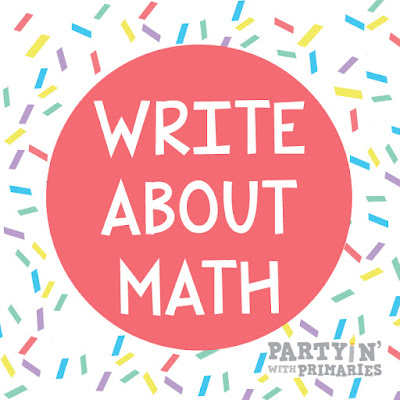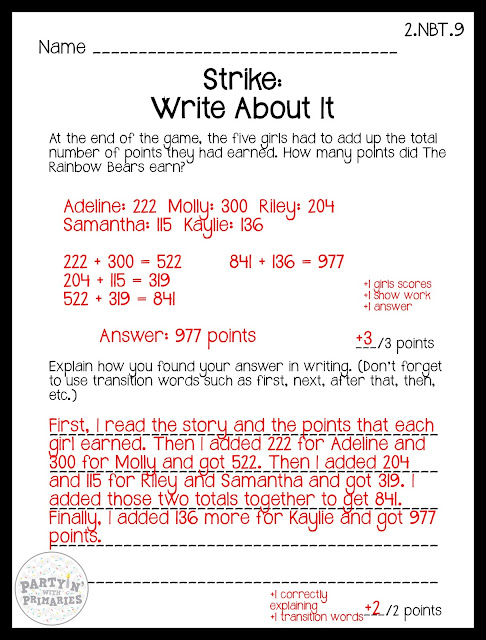Oh, how guided math has changed my life for the better! My Master's Degree is in literacy and I would teach reading groups all day long if I could... but what I discovered along the way is that I ACTUALLY do love teaching math, when I do it correctly! When I made the switch from 5th grade down to 1st, I began doing flexible grouping for guided math and it made all the difference. My only regret is that I didn't start doing it sooner (because as you'll read from several other bloggers in this link-up, it CAN be done well in upper grades too!)
So you have read from several other bloggers on this link-up about using data to drive your instruction and differentiating your groups. One thing I love about guided math is it gives you a chance to mix up your kiddos. Chances are the kids grouped together for guided reading will not be in the same group with students for guided math! If you haven't read other blog posts, you'll need to be sure to PRE-ASSESS for each unit and use that data to create your guided math groups.
Now what can be overwhelming at first, in my opinion, is not only creating differentiated lessons to meet the needs of your different groups, but what to do with the rest of the class while you're pulling groups! DO NOT FEAR, it really is quite simple. Once you set up your stations, they run by themselves!
You'll want to create a visual aid for your students so they know exactly where to go. Our math block is 60 minutes so we do three rotations each day and I split the kids into groups of approximately 6-8 students... it's not ideal but you can only do what you have time for.
We have four rotations that the students follow on a odd/even day basis.
So each day, every student sees me for Guided Math PLUS two centers.
Then the following day they see me, PLUS the other two centers.
These EDITABLE POWERPOINT templates are available for download by clicking HERE.
Here is an example of a student's schedule that will be portrayed on the board as a visual reminder.
Ex. Day 1 Day 2
Rotation 1 - Guided Math Rotation 1 - Math Using Technology
Rotation 2-Math Partner Games Rotation 2 - Guided Math
Rotation 3 -Write About Math Rotation 3 - Read About Math
Let's break it down...
The first station is so simple, it's too good to be true. How many of you feel like you're bending over backwards to provide your students with cross-curricular instruction? Well, here is a simple way to do it! Provide your students with books about math. They can be simple picture books that reinforce math concepts. I had a student teacher that made it her project to create questions and games to go along with the books, giving each book a folder... that is a BONUS and not necessary. These books do not need to be leveled, the pictures will often support the words and concepts.
If you do scholastic book orders in your classroom, you can get TONS of these books for FREE! Brian P. Cleary, Jerry Pallotta, and Loreen Leedy are great authors to get started with to build your library!
The second station also incorporates literacy. The shifts in the common core requires not only solving math problems but articulating WHY and HOW answers are found. The Write About Math station covers both of these aspects. I created for my students several word problem prompts that review previously taught concepts during the year. The students glue the AND explain in written paragraph how they found their answer.
(Click on the image above for the link to this product)
Although school is most definitely academic, it is also social. Math Partner Games, the third station, allows students to work collaboratively and interact socially while reinforcing previously taught concepts.
We have a math manipulatives corner in my classroom, in which students can find the tools they need to play the games successfully. Generally, I will leave out the items necessary to play the specific games and they will help themselves to supplemental manipulatives.

Our school uses Math Investigations, which comes with several games. I found the maintenance of these games overwhelming, so over summer breaks I would copy the game boards and direction sheets and then laminate them. This way I could pull the file folder out with the game that went along with the skill I wanted to reinforce and not have to reinvent the wheel each day!
As an added bonus, the storage bins served as seats at our guided math/reading table! Pretty neat way to save space and the kids LOVE them!
Math Using Technology, the fourth and final station, is ALWAYS a favorite of my first and second graders! We are very fortunate to have four desktop computers in my classroom, plus I wrote a grant for two additional laptops. Our school had a laptop cart and an ipad cart that could be signed out for a portion of the day as well, and I definitely love to take advantage of that!
There are several websites that are FABULOUS such as ixl.com -- which can be used without paying a fee, however you can not track your students work unless you subscribe. After a colleague and I used it in our classroom, we presented it to the administration and they bought a school-wide subscription. fun4thebrain.com, xtramath.com, and splashmath.com can all be used without subscriptions as well.
I have my students keep a simple log of what they worked on that day, so there is a form of accountability for their actions... as we all know that is sometimes necessary! Though the fear of losing the privilege of technology is enough for most kiddos to stay on task!
Do you have any additional websites you use in your classroom??? I'd love to hear about them in the comments section!!!
NOW, I realize everyone does not have access to computers and ipads in their classrooms... that is not the only form of math technology. Calculators are a great tool for kids to learn to use... or you could change the station to be the WILD CARD STATION in which some days kids do fact fluency practice, differentiated worksheets (blah.. as much as I hate worksheets, I do realize repetition in math is ESSENTIAL and sometimes necessary in math), games, word problems, etc.
So as you can see, much of the work for the math rotations is front loaded. Once you do the following:
1. Create your visual schedule for the students. (CLICK HERE for the free editable version of the one I use in my classroom)
2. Gather your Read about Math books -- your school librarian should be able to be helpful with this as well. If you call and ask him/her to pull books for you, they generally have a good supply on hand! If you are interested, I have Leveled Reading Comprehension Passages with Math Concepts available for purchase that include math questions as well as written response questions that could be used for Read About Math or Write About Math)
3. Gather your Write About Math prompts -- They can be as simple as two step word problems, generated on your own or pulled from your curriculum. My Second Grade Math Story Problems and Math Review Bundle contains several word problems to get you started.
4. Organize your Math Games -- if you take a look at your manipulatives, you can make up several games just using Base Ten Blocks and Dice.
5. Set up your Math Using Technology or Wild Card Station with an optional form of accountability for your students.
**Hint: It's helpful to add frequently used websites to the FAVORITES column on the computers for students to find, without asking for your help.**
Want some more SMASHING STRATEGIES for GUIDED MATH?? Check out these other blog posts!
























Two questions. First, when would students do independent work based on the minilesson? Second, how often do you grade their "writing about math"?
ReplyDeleteHi!
Delete1. For independent work I will mix things up... sometimes I will turn the "Read about Math into Independent Work and THEN Read about Math when they're finished OR switch out math with a partner for independent work, just depending on my goals for the day! Sometimes I will do a "ticket out" during the wrap up at the end to see if they have grasped the concept as well!
2. I typically collect the journals randomly every week. I do not grade them all each day, too much! But at the end of every Day 2 I will list off 5-7 kids names and have them leave their journals in the work bins for me to collect. I also had a TA or parent volunteer in my class for math block, so they would be assigned to the write about math station for additional assistance AND to make sure kids were getting it! Hope that helps!
HI! I'm curious, what do you do in your guided math? Also, after day one and day two, do you repeat day one rotations on the third day and day two on the fourth day? Do you do rotations on Fridays? Are you doing whole group as well? (Love the rotation system by the way! I had a hard time figuring how to see everyone but not have the centers full over crowded with kids! Thanks so much for sharing!)
ReplyDeleteHi Martha! So sorry for the delayed response.. my family was on vacation!!!
DeleteFor my guided math groups, I simply teach differentiated versions of what I would have typically done as my "whole group lesson." Just teaching to smaller groups...
I do repeat every day.... Ex.
Monday - Day 1
Tuesday - Day 2
Wednesday - Day 1
Thursday - Day 2
Friday - Day 1
Monday - Day 2
(you get the idea)... On Fridays I would sometimes do my assessments that I needed to do during groups, etc. fact fluency, anecdotal assessments, etc.
I start every rotation with a quick 5 minute mini lesson introducing the concepts we will be learning and reviewing the rules for the centers, and the expectations for each. I model anything that needs to be explained for the centers and then we get started as soon as possible! My math block was 60 minutes so I tried to do 3 groups for 15 minutes each, with the whole group mini lesson at the beginning and then quick whole group wrap up at the end (plus transition times). I found it WAYYYY more effective and helps to keep centers from getting overcrowded!
If you have any further questions, please feel free to email me at partyinwithprimaries@gmail.com I would be happy to answer any other questions!! :) Again, sorry about the delayed response! Happy teaching!